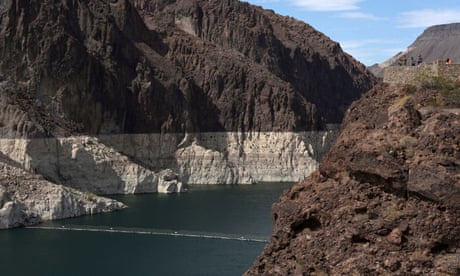Extract from The Guardian
Officials issue first-ever declaration of tier 1 shortage at Lake Mead as it falls to lowest level since its creation.
Footage shows low water mark at biggest US reservoir as shortage declared – video
Last modified on Tue 17 Aug 2021 22.06 AEST
Officials have declared a dire water shortage at Lake Mead, the US’s largest reservoir, triggering major water cuts in Arizona and other western states. The US Bureau of Reclamation’s first-ever declaration of a “tier 1” shortage represents an acknowledgment that after a 20-year drought, the reservoir that impounds the Colorado River at the Hoover Dam has receded to its lowest levels since it was created in the 1930s.
Already, the lake is at about 35% capacity – the white “bathtub ring” that lines its perimeter indicates where the water level once was. The lake’s level is projected to fall even lower by the end of the year, prompting cutbacks in January 2022, the Bureau of Reclamation announced Monday.
Arizona will be hardest hit, losing nearly a fifth of the water it receives from the Colorado River. In Pinal county, farmers and ranchers will see the amount of water they get from the river drop by half next year, and disappear altogether by 2023, when the federal government is projected to enact even more severe cuts. Farmers, who have already had to make some land fallow, will probably have to continue to do so in the coming years and rely increasingly on groundwater.
“What we hoped we would never see is here,” said Camille Calimlim Touton, a deputy commissioner at the Bureau of Reclamation. “At the heart of today’s announcement is also an acknowledgment of the hardship the drought has brought.”

Household water supplies will remain unaffected, though families are likely to see their water prices tick up.
“This is a very big deal, because there’s never been a shortage like this over the almost 100-year history,” said Sarah Porter, director of the Kyl Center for Water Policy at Arizona State University. “The immediate impacts of this will not probably be felt by most people. But it’s a big, giant red flag telling a region that is dependent on Colorado River water that we need to adjust to a drier future.”
Cutbacks and conservation efforts – though crucial – are unlikely to reverse the reservoir’s decline in the near future. When it’s full, Lake Mead’s elevation sits at about 1,221ft above sea level. But by next year, the lake’s level is expected to drop to 1,065ft, below the 1,075ft cutoff that triggers first-tier water reductions. By 2023, federal officials and water experts expect a tier 2 shortage. And when the lake’s level dips to 1,025ft, a tier 3 declaration will trigger supply cuts to cities and tribal lands.
Lake Mead, which was formed after the construction of the Hoover Dam in the 1930s, has been declining faster than many experts predicted, amid a devastating drought and intense heatwaves that have resulted in less water trickling down from the Rocky Mountains into the Colorado River. The dam, which provides power to about 1.3m people in Nevada, Arizona and California, has seen its efficiency drop by 25%, according to the Bureau of Reclamation.
The Colorado River system overall is now at half its capacity, according to the US interior department. The past 16 years have been the driest period the basin has seen in 1,200 years, the agency reported. Although the west has endured periods of extended drought, the current conditions have been exacerbated by the climate crisis, which is fueling longer and more severe dry spells, scientists have made clear.
Federal officials recognize “the very real possibility that the hydrology that we planned for years ago may not be the worst the basin may see in the future”, Touton said. Additional actions, cutbacks and conservation efforts “will likely be necessary in the very near future”, she explained.
The water level in Lake Powell, the river’s second-largest reservoir, has also been dropping precipitously, threatening to disrupt the roughly 5bn kilowatt hours of electricity generated each year at the Glen Canyon Dam. It is currently at 32% of full capacity.
“I think in the next five years, what we need to do is have a reckoning over our water use,” Porter said. “We have to rethink how we use water in the western US.”
No comments:
Post a Comment